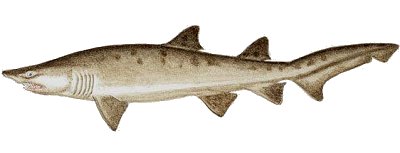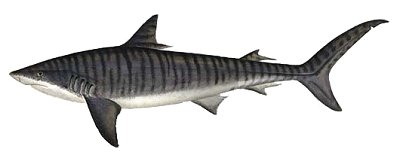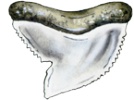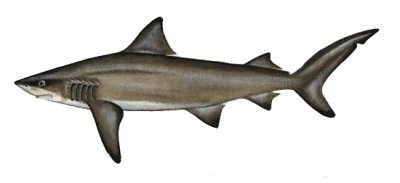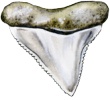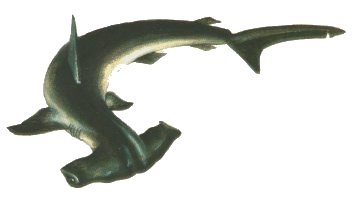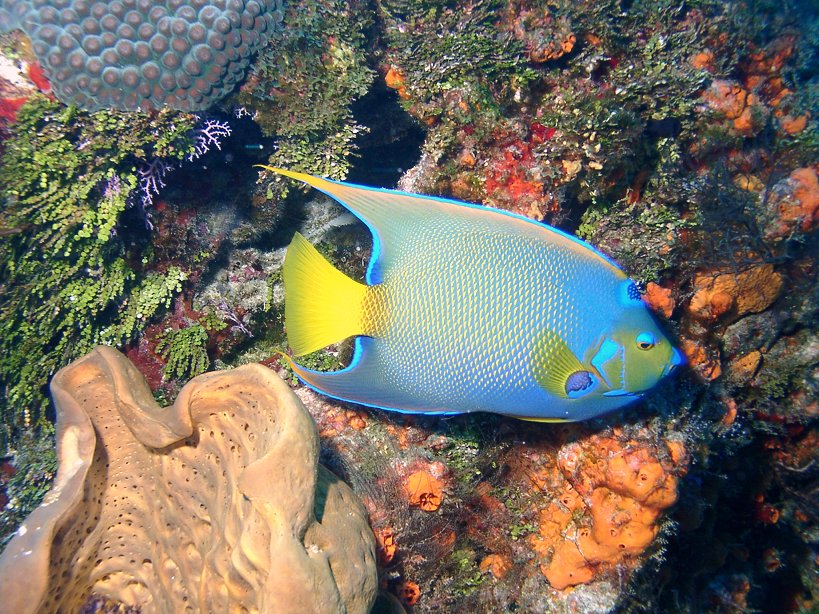Here is an assortment of large sharks that can be found in New Jersey waters, by no means all of them. These are more likely to be found inshore in coastal waters. Sharks are seldom a danger to divers, they seem to be put off by the noise and bubbles. Nonetheless, all should be treated with caution.
In all my many inlet dives, I have seen a shark once, and that was in inoffensive Smooth Dogfish. I have been told that they are sometimes seen from up on the bridge in Belmar, but even then they would probably be out in mid-channel, and far away from strange noisy bubbling scuba divers. However, one of the most famous shark attacks of all time took place in New Jersey - the 1916 Matawan Creek attacks. See Bull Shark for details.
The only one of these that you are ever likely to encounter in local ocean diving is the relatively inoffensive Sand Tiger, not the similarly named and extremely dangerous Tiger.
This page has many spectacular photographs of sharks. That is because people are fascinated by these sleek and deadly predators, and there are many many great pictures on the internet to choose from. But don't be alarmed - your likelihood of encountering a dangerous shark in New Jersey waters while diving is near nil. If you note the water clarity in most of these pictures, you will realize that they were not taken anywhere near here!
Carcharias taurus
Size:
to 11 ft
Habitat:
coastal waters
Notes:
dangerous if provoked, usually unaggressive
Sand Tiger sharks have a broad inshore distribution. In the Western Atlantic, this shark occurs from the Gulf of Maine to Florida, in the northern Gulf of Mexico, in the Bahamas, and in Bermuda. The sand tiger shark is one of at least four species belonging to the family Odontaspididae. Synonyms include Carcharias taurus, Eugomphodus taurus, and Carcharias arenarius.
More: Sand Tiger Shark ...
Galeocerdo cuvier
Size:
to 24 ft
Habitat:
open ocean, also enters rivers and bays at night
Notes:
extremely dangerous
The serrated teeth are designed for sawing chunks from large prey items
If you are going to worry about a shark, let it be this one. Tiger Sharks are big, bold and inquisitive, and frequently come close inshore. They are also remarkably undiscriminating in their eating habits, which makes them even more likely to attack a swimmer, or anything for that matter.
More: Tiger Shark ...
Carcharhinus leucas
Size:
to 12 ft, perhaps larger
Habitat:
coastal waters, bays, rivers, into freshwater
Notes:
dangerous
The Bull Shark can be recognized by a combination of characters including a stout body, short blunt snout, triangular serrated teeth in the upper jaw, and no fin markings as an adult. This species has a second dorsal fin about one-third the height of the first, a small eye, and no skin ridge between the two dorsal fins. It is gray above and pale below, sometimes with a pale stripe on the flank.
More: Bull Shark ...
Sphyrna lewini
Size:
to 13 ft
Habitat:
coastal waters
Notes:
dangerous
Sharks such as the Hammerhead, that have their eyes positioned on lateral extensions of their heads belong to the family Sphyrnidae. ( Sphyrna is Greek for hammer. ) Four species occur in the region:
- Scalloped Hammerhead Sphyrna lewini - most common
- Smooth Hammerhead, Sphyrna zygaena - most northerly
- Great Hammerhead, Sphyrna mokarran - largest, mainly tropical
- Bonnethead, Sphyrna tiburo - smallest
More: Hammerhead Shark ...

